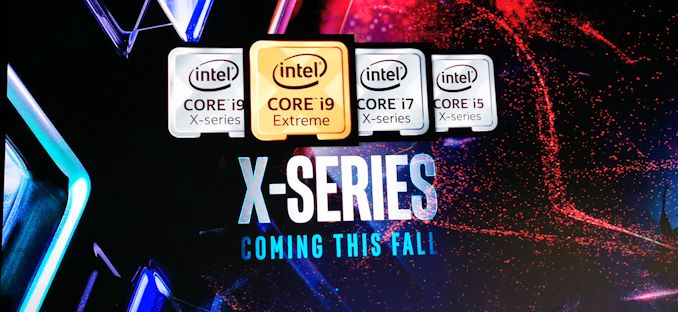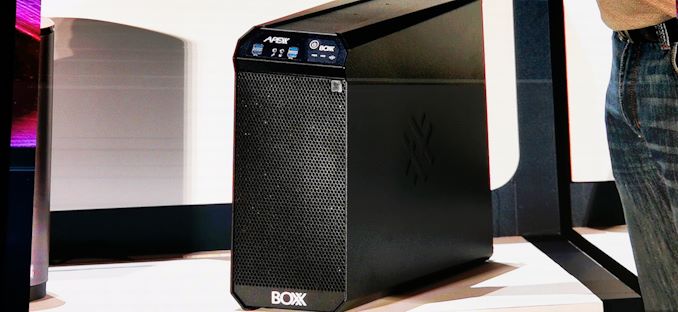Intel to Launch New X-Series CPUs this Fall
by Ian Cutress on May 28, 2019 2:00 AM EST- Posted in
- CPUs
- Intel
- HEDT
- Core i9
- Computex 2019

Today at the Intel Keynote at Computex, SVP and GM Gregory Bryant announced that Intel is set to bring new X-Series CPUs to the high-end desktop (HEDT) market during Fall/Autumn, so around Q4. No other details were presented, but these are likely to be based on the new Cascade Lake silicon we’ve seen launched for the Xeon Scalable market in Enterprise later this year.

Acer BOXX: Core X-Series Inside
Core counts for Cascade Lake go up to 28 cores, however the previous generation X series went up to 18 cores. It will be interesting to see what Intel does with these new processors regarding socket support. Intel did state that there will be increases in memory support, CPU frequencies, and Turbo Boost Max beyond two cores.
More information to follow.
| Want to keep up to date with all of our Computex 2019 Coverage? | ||||||
 Laptops |
 Hardware |
 Chips |
||||
| Follow AnandTech's breaking news here! | ||||||










37 Comments
View All Comments
SaturnusDK - Tuesday, May 28, 2019 - link
Too little, too late.But it is nice to see that the pressure of being 2nd best is moving Intel along.
Dizoja86 - Tuesday, May 28, 2019 - link
I hope that was just a poor attempt at humour.sgeocla - Tuesday, May 28, 2019 - link
You can only do so much with monolithic dies and 14nm refreshes.Every 2 cores added massively decrease yields, binning potential and increase prices.
Looks like Intel has at least learn a lesson and the case is black so you can't see the insides.
imaheadcase - Tuesday, May 28, 2019 - link
None of that matters considering all the leg room they have to play with though. Its not like AMD is magically going to steal market share with one release. Intel users are not simply going to toss motherboard/ram out just to switch to AMD. Its cost prohibitive to do that. A few hundreds bucks difference in a CPU is still a big investment to move to another eco system.Irata - Tuesday, May 28, 2019 - link
If you have a good enough PC, there is no reason to throw it away just to get something slightly faster for your use case.At some point, however, you will need to replace your system, either because it has become too slow for your use case, something breaks, it does not support new peripherals....
In the server space, this may be different - if you can suddenly get the same or better performance for considerably lower power use (which also translates into lower cooling costs), replacing your existing hw could very well be worth it.
sgeocla - Tuesday, May 28, 2019 - link
Most people think AMD has been knocking Intel's HEDT platforms & prices back to earth with 12nm air cooled Threadripper vs 14nm++ water cooled Intel.Next 7nm Threadripper will have 2x AVX performance, 50% to 100% higher number of cores, 40% lower power consumption, no NUMA bugs, PCIE4 with plenty of lanes.
While Intel can only make 28 core dies with 10% yield, AMD can make 32, 48, 64 core CPUs with 70% yield.
Karmena - Tuesday, May 28, 2019 - link
You have to toss the mobo out with CPU upgrade on Intel. At least you usually had to.futrtrubl - Tuesday, May 28, 2019 - link
You quite often have to toss the motherboard on an upgrade anyway, or get new features from new ones. Both AMD and Intel use the same RAM for equivalent generations, so if you had to toss RAM to change companies you would have to toss RAM to upgrade within the ecosystem.0ldman79 - Tuesday, May 28, 2019 - link
You have to toss the mobo on an Intel setup.I've had AMD systems run at least four generations of CPU on a single board, Athlon x2, Athlon II, Phenom and Phenom II. Couldn't quite get DDR3 into that damn DDR2 slot though...
sorten - Tuesday, May 28, 2019 - link
"Intel users are not simply going to toss motherboard/ram out just to switch to AMD"I'm not going to toss it out. I'm planning to give it to my brother. Reduce-Reuse-Recycle. :)